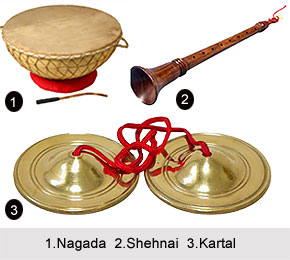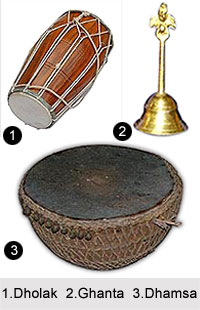 The music reflects the moods which the dancers interpret well. The vocal music does not play a major role in Purulia Chhau. It is very short and its song-poem does not contain more than two lines. Each item is introduced by such a song and as soon as the two lines are sung by the vocalist, the drummers begin to beat their drums. In Bandyoyan area the vocalist does not give up his song during the progress of the dance instead goes on repeating the same introductory lines defying the loud beat of drums. In Purulia Chhau dance the language of the songs is Bengali mostly sung by the bi-lingual aboriginals who are not used to it being inhabitants of the border district of Purulia.
The music reflects the moods which the dancers interpret well. The vocal music does not play a major role in Purulia Chhau. It is very short and its song-poem does not contain more than two lines. Each item is introduced by such a song and as soon as the two lines are sung by the vocalist, the drummers begin to beat their drums. In Bandyoyan area the vocalist does not give up his song during the progress of the dance instead goes on repeating the same introductory lines defying the loud beat of drums. In Purulia Chhau dance the language of the songs is Bengali mostly sung by the bi-lingual aboriginals who are not used to it being inhabitants of the border district of Purulia.
At times the vocal songs are independent of the theme presented through the dance. Couplets have been detached from their context and are sung irrelevantly according to the will of a vocalist. The lines are allegorical of some material thing or idea. There are lines which probably due to their lyric character are being widely sung. No importance is attached to the vocal music of Chhau dance even by the rural spectators. When vocal music is sung introducing a scene no instrumental music is played. When the lines are repeated, a loud beat of drums makes the songs muted. The instrumentalists tune with the steps of the dancers. When a pathetic scene is performed in dance the introductory song-poem of the vocal music may be a bit lengthened but does not exceed five couplets.
 It not only narrates the coming event, but gives expression to the pathos it bears. As the dance is heroic the vocal music is insignificant as in others. The instrumental music is the most important in Chhau dance. The musical party or the orchestra consists of two or three big tribal drums. It is known as Dhamsa, each beaten with two hands by two sticks and two cylindrical drums known as dholak slung from the shoulders of two musicians who play them with their palms and fingers. The dholak is played on both its sides at times by a stick on one side and by palm and fingers on the other side. To this is added the notes of shehnai. The practice of playing of music of Chhau dance of Purulia is confined to Dom community.
It not only narrates the coming event, but gives expression to the pathos it bears. As the dance is heroic the vocal music is insignificant as in others. The instrumental music is the most important in Chhau dance. The musical party or the orchestra consists of two or three big tribal drums. It is known as Dhamsa, each beaten with two hands by two sticks and two cylindrical drums known as dholak slung from the shoulders of two musicians who play them with their palms and fingers. The dholak is played on both its sides at times by a stick on one side and by palm and fingers on the other side. To this is added the notes of shehnai. The practice of playing of music of Chhau dance of Purulia is confined to Dom community.
Dhamsas are beaten on one end by one person when their size is moderate, but when the size is bigger it is beaten by two persons simultaneously. The dholaks being smaller in size can be slung from shoulder. They also take active part in the dance sometimes shouting the sound of the strokes of their music and at times jump in the air with great excitement. Those who beat the war-drums and play on the wind instrument shehnai, have no physical movement for them to perform. They have to keep tune with the war-drums on one hand and with the footsteps of the dancers on the other. Those who play on the smaller drums have a vital role.
In Mayurbhanj Chhau dance in addition to the above musical instruments two others are also employed: chadchadi and tikra. The music has been made more complicated with the addition of these two instruments.
In Seraikella, the music has been made most complicated by addition of a number of instruments like Nagada, Ghanta and Kartal. Some improvement in the character of the music was intended due to which additional instruments have been introduced both in Mayurbhanj and in Seraikella.



















